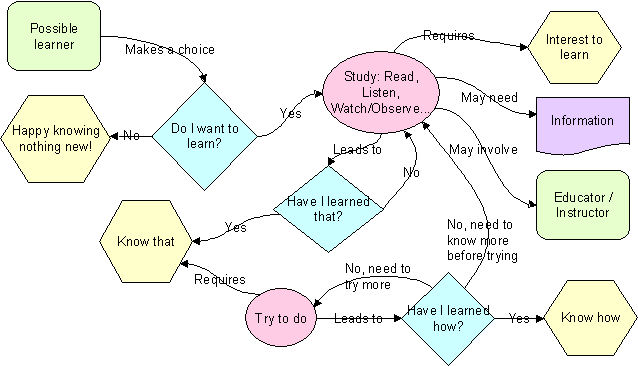Understanding the process of learning
The process of learning

Measurements
When trying to find a suitable way for measuring the success of learning, one could start by looking at how this is done today and how it is done in similar fields. If we look at the field of AI we find that there are simple models for evaluating an algorithm by looking at the accuracy perhaps in terms of precision and recall. If we were to apply this kind of approach we could have the following example:
A person is learning the names of the countries in the EU. When trying to examine whether he has learned them or not, this person states a number of country names. If the answer contain the correct 25 countries and no others then the precision would be 100% and the recall would also be 100%. But if the answer contained 100 countries (including the correct 25) then the precision would drop to 25% while recall would still remain at 100%. If the answer only contained 15 of the countries and only them, then recall would be 60% while precision is 100% (since no wrong countries were included in the answer). One could then take an algorithm combining these two measures into one and have a nice system for measuring who has succeded in learning the countries of the EU best.
This is admittedly an easy method to measure things, but sadly it is difficult to apply it to things that are not just right or wrong. Knowledge is more flexible than black or white. It comes in different shades and something that is not completely correct doesn't have to be completely incorrect either. One could of course approach this problem with the simple notion that everything can be broken down to smaller parts until you do reach a level of true or false. Then one could also combine a mathematic operation to calculate a deviation from the optimal answer or performance, and voilà, you can measure anything. Only problem is, how do you decide the structure and how do you assign the correct weights? If we look at our example from before, then if we get two answer with 26 countries each, out of which 25 are correct and the 26th is either Norway or Australia, then are they both equally wrong? And this brings me to my next point: It is not enough to consider how much is learned correctly, but also how much is learned incorrectly.
When it comes to measuring skills or performing something that you have learned, it becomes even more difficult, since there may not be a correct way or the best way may not be possible to establish.
Another issue to consider when measuring the success of learning is the effort put into the learning. The question becomes then whether you want to measure the result itself or whether you want to measure the effeciency of the learning method.
| This site has been created and is maintained by nikos dimitrakas. For information about this site contact nikos@dsv.su.se |